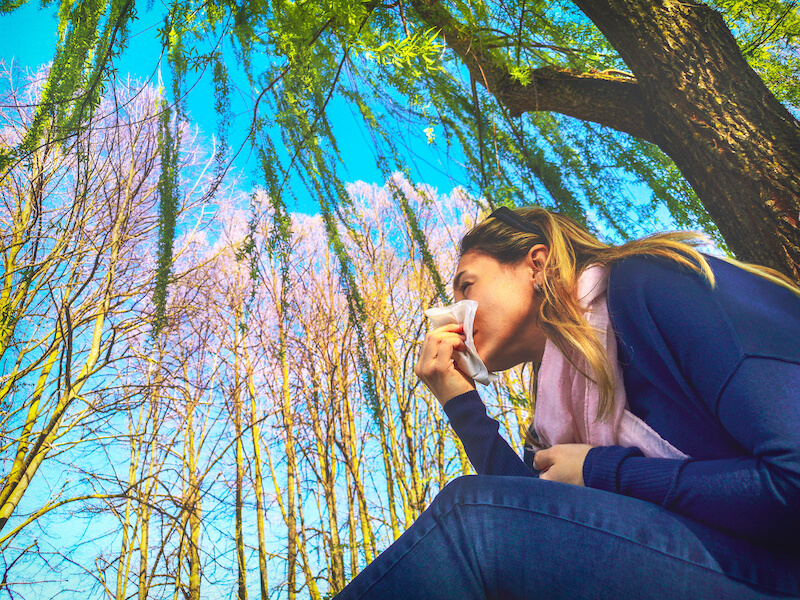
Ah, Spring! Winter was so long but you’re finally able to open up those windows and….begin sneezing. Okay, that sneezing part isn’t so enjoyable. But there’s no questioning the reality: allergy season is upon us.
In any given year, allergy season generally lasts from March to October. Does that mean you’ll have nine months of itchy eyes and runny nose to look forward to? You don’t necessarily need to. And there are a few reasons why you may have some relief to look forward to.
What are seasonal allergies?
When we think about “allergy season,” it’s generally referring to, well, seasonal allergies. But let’s back up and understand what produces allergies in order to better understand what seasonal allergies are. Generally speaking, an allergic reaction happens when your body mistakes a harmless substance for something hazardous and triggers your immune system in an attempt to safeguard you.
Itchy eyes, sneezing, coughing, runny nose and other cold similar symptoms, commonly linked to seasonal allergies, are normally the result. More severe issues, such as swelling, difficulty breathing, or even more serious issues could also be experienced depending on the allergen.
The human body, obviously, has no limit to what it could be allergic to. But it’s fairly common for individuals to be allergic to outside particulates, like pollen or mold spores. Because those pollens (or spores or other particles) often appear seasonally (every spring, for example), you wind up with allergy symptoms that also develop seasonally: hence, seasonal allergies.
Planning the 2022 allergy season
So what does the 2022 allergy season have in store for you? You’ll probably need to assess the year on a month-to-month basis in order to try and produce realistic expectations.
April allergies
If you seem to be sneezing and coughing in April, the responsible party may actually be the trees outside your house. For many, this is surprising because we don’t usually think of trees as generating anything other than, well, leaves. But trees are pollinating plants, too!
If the first few weeks of spring are especially difficult, you may be allergic to maple or ash trees which begin to pollinate in April. If you keep track of the pollen count on any weather app, you can make the decision to regulate your symptoms by remaining indoors if the pollen count gets too high.
Allergies in May and June
The next set of allergenic plants usually start flowering in May and June. Mostly, these pollens are made by grasses and flowers. Because of the ample amount of rain that falls in April, May, and June, these pollens are usually quite potent and widespread. Meaning that if you’re allergic to these green grasses and flowering plants, May and June will probably bring about protracted symptoms.
Try to get any outdoor work done in the morning or evening as these pollen counts have a tendency to reach a peak in the early afternoon.
You may get a break in July
It’s dryer in July generally speaking. This means you might actually get a break from allergy symptoms. Obviously, this will vary from year to year and depends significantly on local weather patterns. So if you have to plan that outdoor family reunion, July will probably be the best time to do it!
August through October allergies
Don’t allow July to lull you into a false sense of security. That’s because August ushers in the beginning of ragweed season. The allergy symptoms from ragweed, also called “hay fever” are very common.
And what’s worse, ragweed lasts a while. This allergen hangs around sometimes into October. Naturally, ragweed isn’t the only allergen that stays around until the ground freezes. Mold allergens can also be rather pervasive at this time of year, too.
Combating seasonal allergies
It can be a challenge to control seasonal allergies. You can attempt to use the timing of your symptoms to determine which specific pollens are making you sneeze and itch. But you may have to contact us for a consultation to really figure out the source of your allergies.
Still, you can decide how to structure your year by learning what time of the year specific allergies peak. This will be as true for future allergy seasons as it is for the 2022 season. You can anticipate a little bit of fluctuation from year to year (in general, allergy seasons seem like they’re getting longer and more extreme all the time), but keep track of your local and regional weather conditions, too.
You can still appreciate being outside even if you have seasonal allergies. Though, it might mean you’ll benefit from a bit of extra planning (and maybe an antihistamine).
References
https://www.mayoclinic.org/diseases-conditions/allergies/symptoms-causes/syc-20351497#:~:text=Common%20allergy%20triggers%20include%3A,from%20a%20bee%20or%20wasp